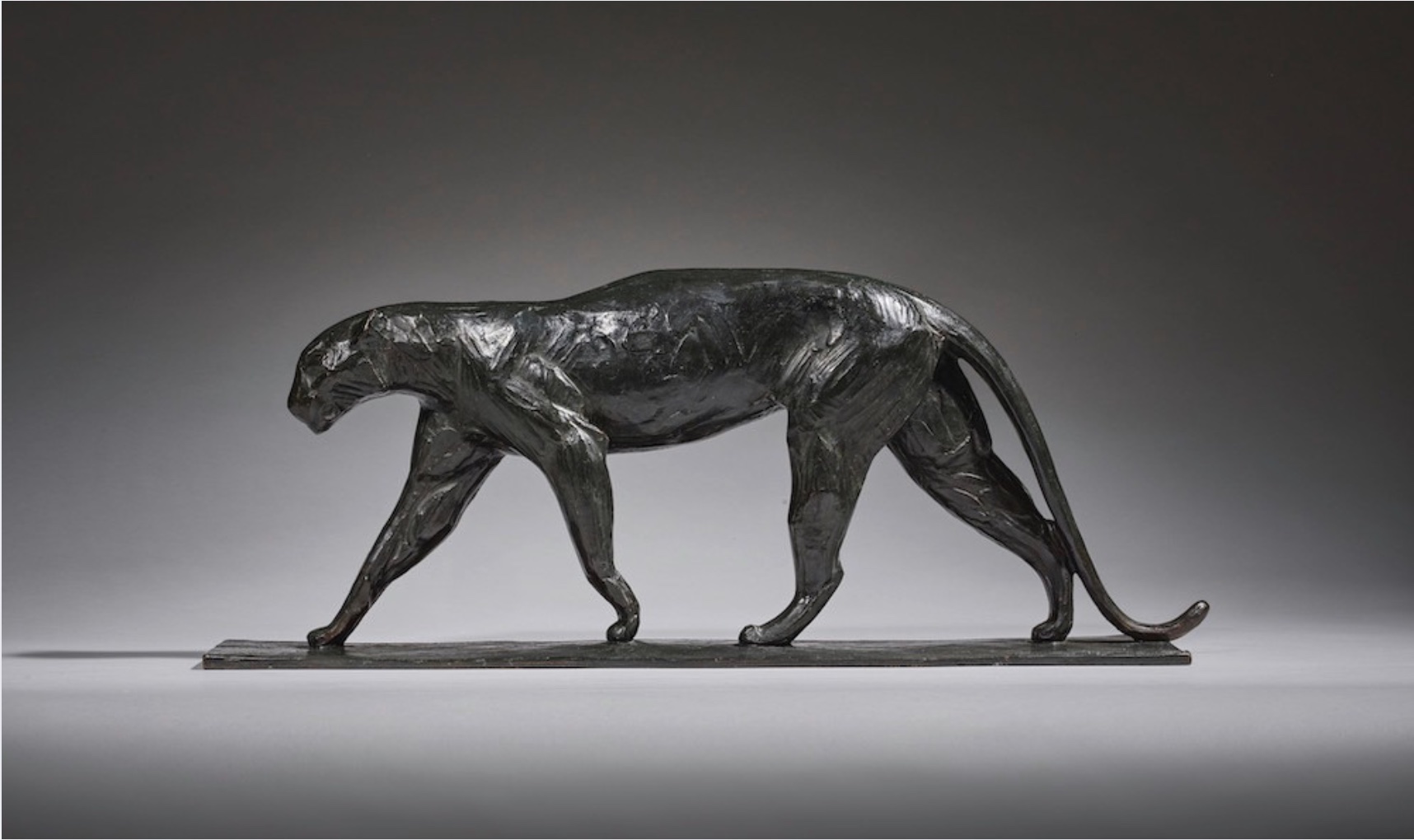
.
.
.
#RembrandtBugatti #BonhamsArtSale #BigCatSculptures #AnimalSculptures #ArtAuctions #LeopardArt #PantherSculpture #20thCenturyArt #21stCenturyArt #ArtCollectors #BugattiMasterpieces #ArtInvestment #BonhamsLondon #AnimalArt #SculptureAuction
Bonhams’ 20th/21st Century Art sale on April 2 at New Bond Street, London, will feature three exceptional bronze sculptures of big cats by the renowned Italian artist Rembrandt Bugatti (1884-1916). These works, celebrated for their lifelike detail and dynamic energy, are among the highlights of the auction. The sculptures include Petit léopard marchant (Walking Leopard, estimated at £220,000-350,000), Léopard au repos ville de Paris petit modèle (Standing Leopard, estimated at £180,000-250,000), and Petite Panther Assise (Seated Panther, estimated at £150,000-200,000). Each piece exemplifies Bugatti’s extraordinary ability to capture the essence and movement of his animal subjects.
Bugatti, born in 1884, was a master of animal sculpture, focusing on exotic species he observed in zoos in Paris and Antwerp. His subjects ranged from lions and leopards to more unusual creatures like anteaters, tapirs, and kangaroos, many of which he introduced as sculpted subjects in European art for the first time. Working directly in front of the animals, Bugatti meticulously observed their behavior to create models that conveyed their most expressive gestures. His intuitive understanding of animal anatomy and movement allowed him to produce strikingly lifelike portraits that remain highly sought after today.
The Petit léopard marchant (Walking Leopard), conceived around 1912 and cast by A.A. Hébrard in a numbered edition of 16, is the most highly valued of the three sculptures. It captures the leopard mid-stride, showcasing Bugatti’s ability to convey fluid motion and the animal’s natural grace. The Léopard au repos ville de Paris petit modèle (Standing Leopard), conceived circa 1911 and cast in a numbered edition of 23, depicts the animal in a poised, alert stance, exuding both power and elegance. The Petite Panther Assise (Seated Panther), conceived in 1912 and cast in a numbered edition of 10, portrays the panther in a relaxed yet commanding pose, reflecting Bugatti’s deep connection with these animals.
Bugatti had a particular affinity for panthers, which he considered his “companions in life and work.” He spent countless hours observing them at the Jardin des Plantes in Paris, where he developed a close relationship with the zookeepers and the animals themselves. Bugatti admired the panthers for their natural behavior and perceived lack of aggression compared to humans. This bond is evident in his sculptures, which capture the animals’ power, agility, and grace with remarkable precision.
Despite his immense talent and success, Bugatti’s life was tragically cut short. He took his own life in 1916 at the age of 31, leaving behind a legacy of extraordinary works that continue to captivate collectors and art enthusiasts. His sculptures are celebrated for their technical perfection, emotional depth, and ability to bring his animal subjects to life.
Ruth Woodbridge, Bonhams Specialist and Head of Department, emphasized the significance of Bugatti’s work, particularly his big cat sculptures. “By choosing to sculpt freehand, Bugatti presented animals as if in motion in a way that is both precise and complex,” she said. “His works show a wonderful understanding of the animal he’s sculpting, and of his works, his big cat sculptures are his most desirable. We expect to see a lot of interest.”
Adrian Dannatt, writing in Bonhams Magazine, highlighted the importance of the three sculptures in the context of Bugatti’s career. He noted that these works come from the artist’s most prolific period, beginning in 1911 when Hébrard exhibited a hundred of his bronze animals in Paris and culminating in 1912 when Bugatti was invited to showcase his work at the Olympic Games. Dannatt praised the technical excellence of the Hébrard casts and the vivid energy of Bugatti’s sculptures, describing them as “anthropomorphic symbols” of the artist’s unique skill. He also remarked on the challenge of achieving such intensity and detail in smaller-scale works, a testament to Bugatti’s mastery of his craft.
The three sculptures in the Bonhams sale represent the pinnacle of Bugatti’s artistic achievement. They not only showcase his technical prowess but also his ability to infuse his works with a sense of life and movement that continues to resonate with viewers. As Dannatt observed, these pieces are a testament to Bugatti’s “singular skill” and his ability to capture the essence of his subjects in a way that transcends time and place.
In summary, the three Rembrandt Bugatti sculptures featured in Bonhams’ upcoming sale are masterpieces of animal sculpture, reflecting the artist’s extraordinary talent and deep connection with his subjects. The Petit léopard marchant, Léopard au repos ville de Paris petit modèle, and Petite Panther Assise each capture the beauty, power, and grace of their respective animals, offering a glimpse into Bugatti’s unique artistic vision. These works, created during the height of his career, are a testament to his enduring legacy as one of the greatest animal sculptors of the 20th century. Collectors and art enthusiasts alike will undoubtedly vie for the opportunity to own these exceptional pieces, which continue to inspire and captivate audiences more than a century after their creation.



